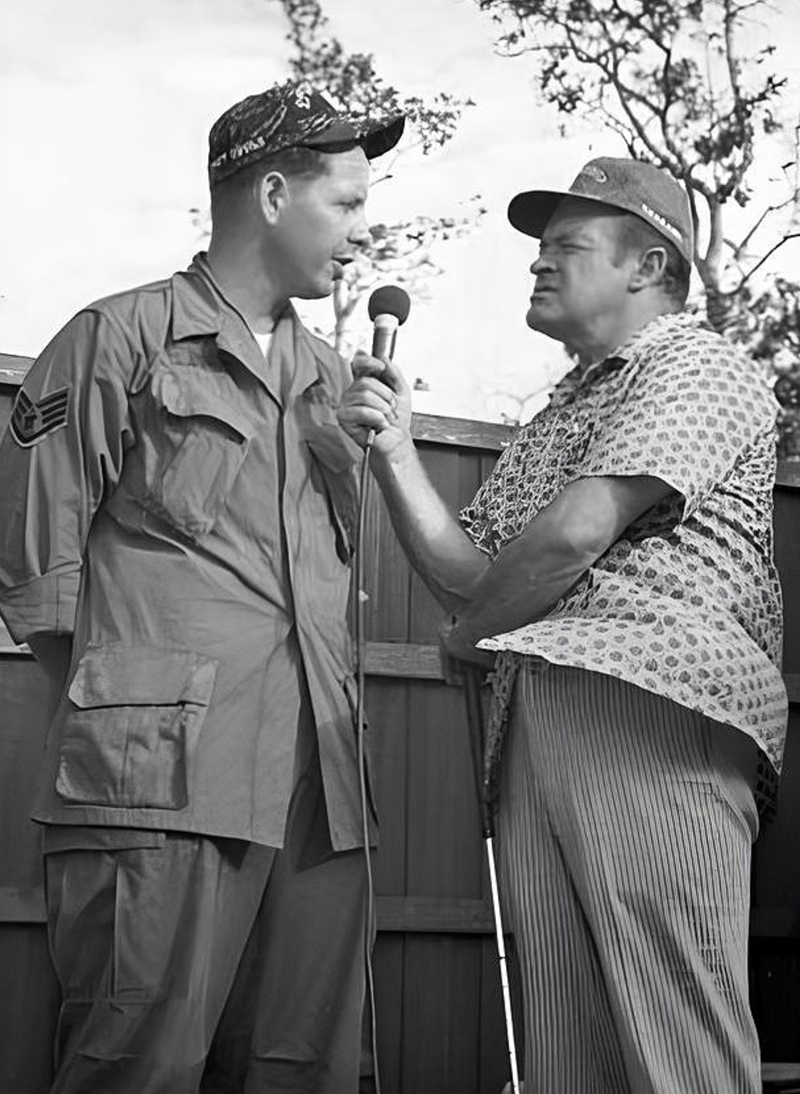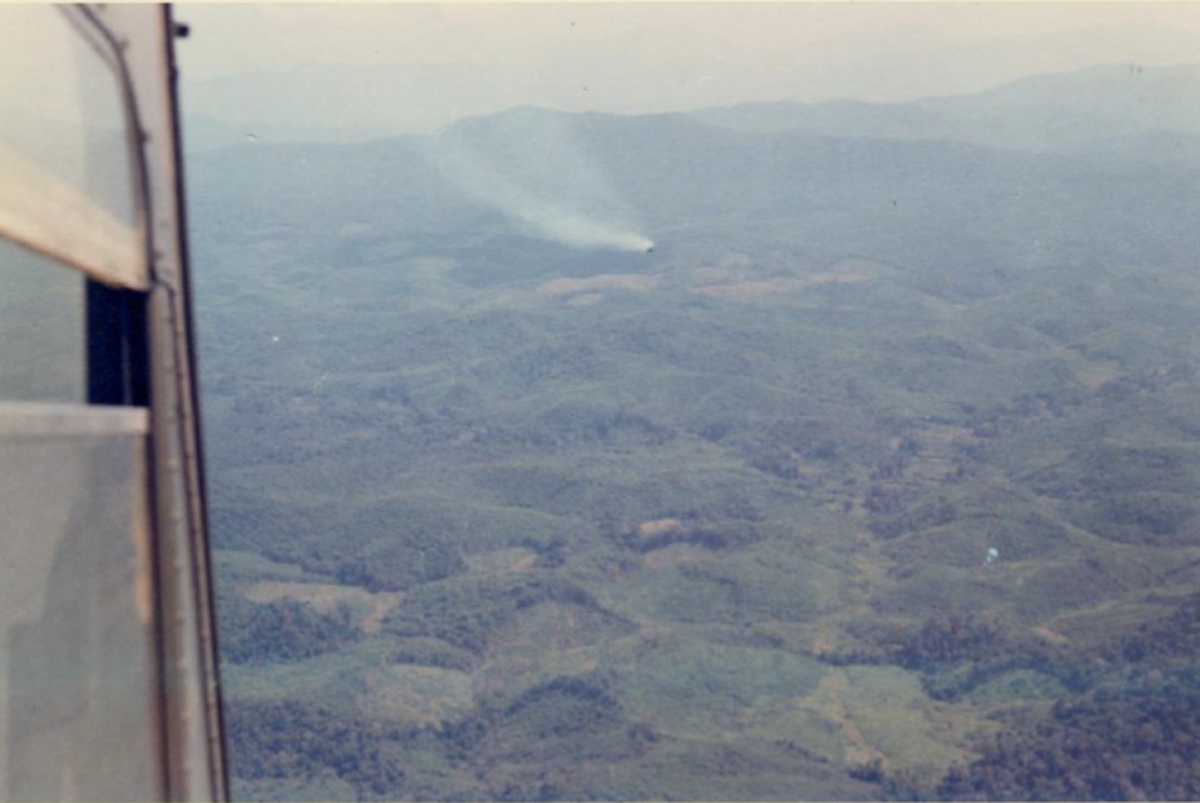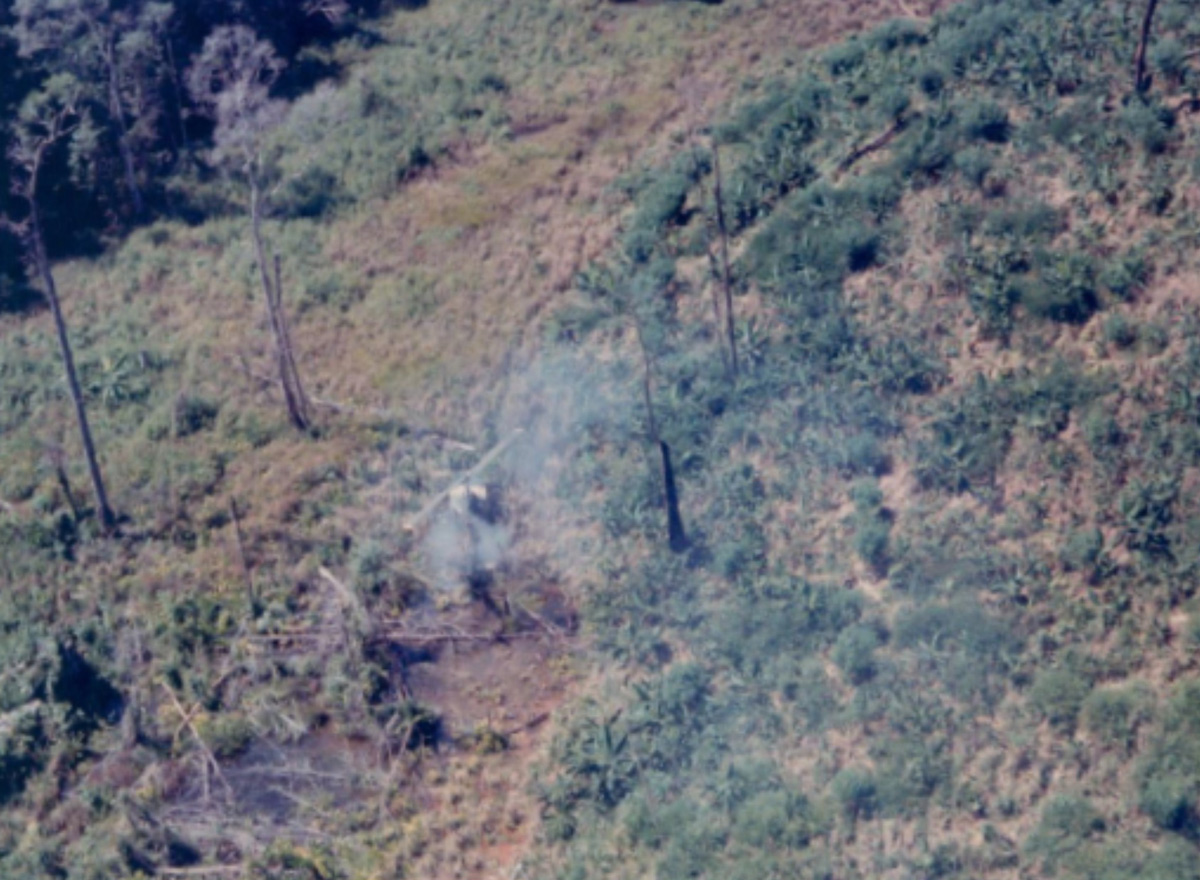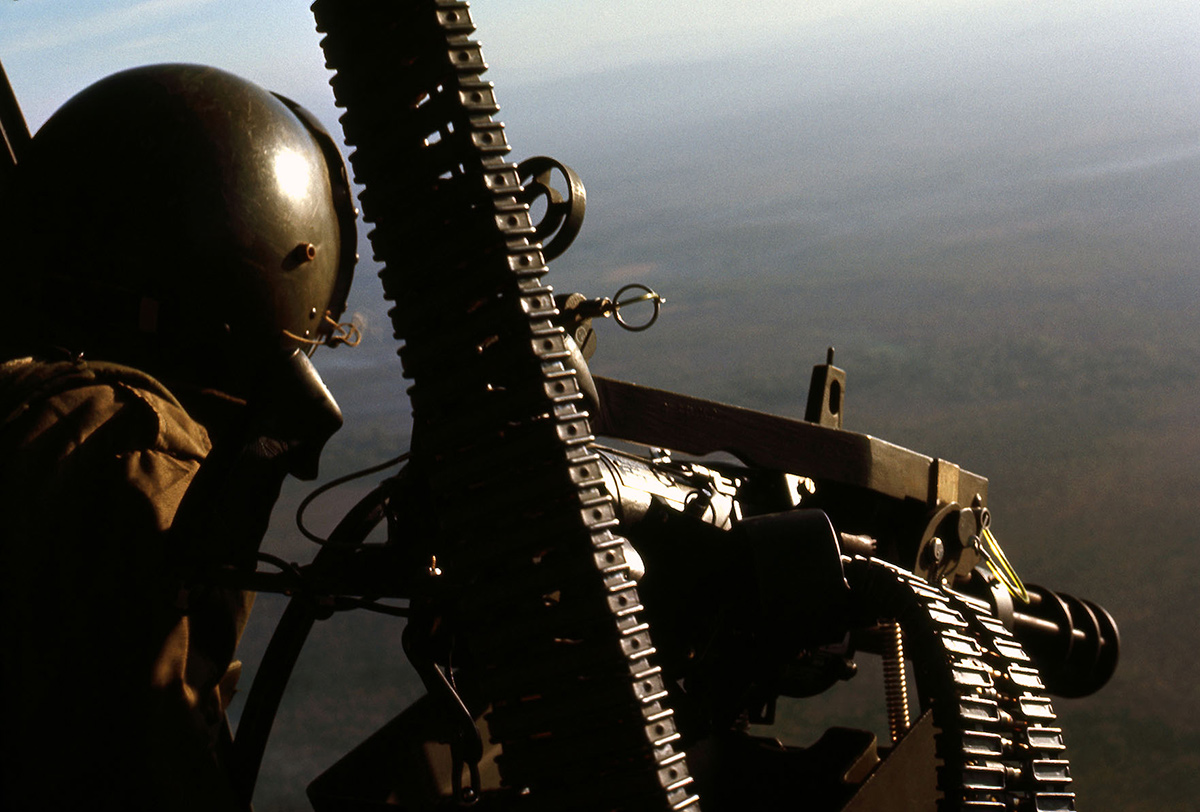

Jim Burns with Bob Hope (Courtesy Jim Burns, from The 20th SOS Green Hornets USAF Vietnam War Volume 1: 20TH SOS GREEN HORNETS in Vietnam)
BY SSGT Jim Burns
“Bird Down in Cambodia” is an excerpt from The 20th SOS Green Hornets USAF Vietnam War Volume 1: 20TH SOS GREEN HORNETS in Vietnam by Jim Burns, Ron Winkles, Charles Svoboda, Jason B. Collins; published by Barnes & Noble Press, 12/15/2024; 228 pages.
We were the only U.S.A.F. UH-I “Huey” helicopter unit in the Vietnam War.
During my tour from June 1967 to March 1968, we were assigned directly to MACV SOG and operated out of forward operating bases at Kontum and Ban Me Thuot, RVN.
This day began, like many others, at the MACV SOG camp at Kontum (FOB Il), RVN, also known as CCC. I had completed my pre-flight on my bird and we received our mission briefing for the day. Our mission was to insert a six-man team (two Americans & four Montagnard ‘mercenaries’) into a landing zone (LZ) along the Ho Chi Minh Trail in Cambodia, near the triborder area of South Viet Nam, Laos & Cambodia. For this insert my bird was designated as “low bird”, which meant we would be carrying the team and making the insert. Our ‘gaggle’ consisted of three Air Force UH-IF ‘slicks’, four Air Force UH-IP ‘gunships’, two Army UH-IB ‘gunships’, an 01 “Birddog” Forward Air Controller (FAC) and a couple of A-I fighters (the A-I’s were not allowed to cross into Cambodia so once we crossed the border, they stayed behind in SVN). My pilot was Capt. John Fiser, CoPilot was 1st Lt. Graham, my left door gunner, was Sgt. O’Leary and I was on the right gun.
We loaded up the team and took off, headed for the LZ in Cambodia. Our ‘slicks’ had M-60 machine guns mounted in the cabin door and each crewmember carried a M-16 automatic rifle, a .38 cal. revolver side arm, a survival vest and a set of chest armor plate. Both Sgt. O’Leary and I wore ‘gunner’s belts’, which was a belt, buckled around our waist with a strap that was attached to a tie down ring in the cabin floor by a buckle. None of us wore the armor plate, aka “chicken plate.” The pilots placed theirs in the cockpit chin windows and us guys in back (GIB’s) sat on ours. The UHF/Ps are the smaller cabin versions of the Huey (like the UH-IB models) and we had removed all the seats, both to save weight and make it easier and faster for the teams to get off or on the bird. On my ‘slick’ we had eight of us in the cabin, two pilots in the front. One of the other two ‘slicks’ had just the two pilots and two gunners and the other ‘slick’ had two pilots, two gunners and a Special Forces medic. The gunship’s all carried the basic four-man crew.
Things were going quite smoothly as we crossed the border, and we were cruising along at about 1,000 feet and preparing to begin our descent and dash to the LZ. We were about ten minutes away from our intended LZ, when suddenly there was a loud “bang” or explosion that came from the engine area, and we lost all engine power to the transmission and rotors.
Capt. Fiser immediately entered an autorotation and called out that we had lost power and we were going down. He called out a “mayday” as we started down. The “Green Hornet” gunships immediately closed in behind us and started following us down. One of the gunship’s called to us that we were on fire with flames and smoke coming from the engine compartment and were trailing a lot of smoke.

Capt. Fiser said the engine was running just fine… but we had no power to the rotor. We found out later that the speed decreaser gearbox (SDG) that connects the engine to the main transmission had blown apart and was on fire. As luck would have it, Capt. Fiser was able to auto rotate to a soft marshy clearing along what looked like a very shallow stream. He did a great job of setting us down safely (one of the softest landings I could remember) and we all began to get our gear and exit the bird, which was still on fire. As soon as we hit the ground the SOG team, Sgt. O’Leary and the copilot exited the left side of the bird. One of them grabbed the fire extinguisher and put out the fire in the left side of the engine compartment. At the same time, I was getting my M-60 machine gun off its mount, grabbing my survival vest, M-16 rifle and as much M-60 ammo as I could wrap around my neck. I jumped out and went about a foot before I was yanked to a sudden stop. When I looked back to see what had grabbed me, I realized I had forgotten to disconnect my gunner’s belt, so I was still attached to the bird. I had to turn around, lay down my rifle and my survival vest, to free up a hand, so I could disconnect my gunner’s belt.
Once this was done, I picked my rifle and survival vest up and started fora large bush a short distance away from the right side of the bird. I glanced back at the bird and saw that Capt. Fiser was still trying to get his cockpit door open. The armor plate on the seat was making it extremely difficult for him to reach around it and get to the door handle. So, I ran back again, laid down my rifle and survival vest and opened his door. He climbed out and I again picked up my rifle and survival vest, then the both of us headed for the large bush for some cover.

We knew we were in a bad area, but we had not drawn any enemy fire or seen any enemy activity so far. Our gunships were orbiting overhead and after a few minutes I turned to look for Capt. Fiser to tell him that I thought we should move to the other side of the bird and join up with the SOG team and the rest of our crew. I went completely around the bush—Capt. Fiser could not be found!! So… here I am, all alone, in an enemy area. Needless to say, it didn’t take me long to decide to head to the team and the rest of the crew’s location on my own. As I came around the front of the bird, I could not see the team anywhere, but I did see another of our helicopters on the ground, around a little curve in the stream bed, about 30 yards off our nose. So, I took off and headed in its direction. Once I got there and hopped in—there was Capt. Fiser, already sitting on the cabin floor. He had thought I had seen the helicopter landing and had taken off and headed that way as soon as he saw it coming in.
We set there for a short time waiting for the rest of the crew and the team to come, until one of our gunships told us to take off and they would send another slick in to fly right over the team and the rest of the crew, so they would see it land, to pick them up. The second bird went in and successfully picked up the rest of the crew and the team and took off. Then someone who was trying to get a head count to be sure that everyone had got out, called our bird and said for us to go back in because there were two still on the ground. As we were making our approach, someone did another head count and realized that the two they thought were still on the ground were Capt. Fiser and me. So, we broke off the approach, climbed out and headed back to FOB ll.
Because of the location where we went down, Saigon would not let our escort fighters come across the border and bomb our bird to destroy it; they did not want any bomb craters in that country. Also, it was about two or three days before Jackie Kennedy was going to be visiting Cambodia and they did not want any political fallout to occur. So, the decision was made that the bird had to be removed from Cambodia before the end of the day.
An Army CH-47 recovery crew, from Pleiku, was tasked to go and sling it out. When they found out where it was located, they initially refused to go get it. My understanding was they received a direct call from Gen. Westmoreland, and he ordered them to get it out of out of its current location. He said he didn’t care what they did with it once they were back in South Vietnam, but that they would get it back across the border that day.
By the time all this was going on, we were back at our camp listening to the recovery operation on the radio. The CH-47 crew did finally get it out, in the dark, and brought it back to Camp Holloway, Pleiku, Republic of Vietnam. The next day they brought it back to FOB Il, where after several weeks of repairs, we finally got it back into the air.
While we were listening to the recovery, one of our gunship gunners, which had followed us down, was telling me how “neat” it was watching us go down. “Flames and smoke trailing behind, it looked just like you would see in the movies”. I gave him a few choice words and let him know that I didn’t think it was so “neat” and not one damn bit funny. He was filming us going down and he gave me a copy of the film. As I look at it now, it does look just like in the movies.
Well, that’s my story (as best I can remember it) of a few moments in my life, one day, in Cambodia, while doing my job on one of my tours to sunny Southeast Asia.
MACV SOG 20th SOS Green Hornet Crew Chief and Gunner Jim Burns
Click on the video below to Jason Collins’s YouTube channel “MACV-SOG: Interviews with Warriors” to view his episode with Jim Burns.
In this interview, you will hear Jim tell some of the stories about his adventures while with the Green Hornets, with some very hairy moments, and some interesting interactions with Jerry Shriver and his motley crew of animals.
In 2007 while I was reading an entry on the Vietnam Helicopter Crew Members Association email traffic I saw an entry from David Wilke about the day, in 1967, he was sent “across the fence” to recover a downed Air Force “Huey.” Knowing that we were the only Air Force unit in the Vietnam War flying the “Huey” and my bird was the only one to go down in Cambodia in 1967, I contacted David to see if it was my bird that he helped recover. It was and David sent me his story of that day which I’ve added below.
By: David Wilke, 189th AHC, U.S. Army
This story is for anyone who has been “there”, done that or, I hope, never has to go there or do that.
29, October 1967
Camp Holloway, Pleiku, Republic of Vietnam
Sunday Morning @11am
I was up, cleaned up and was writing letters when a dispatch runner from HQ came to my “hooch” and I was told to report to HQ ASAP. I immediately grabbed my Browning 9mm, Survival Knife and Helmet and went to HQ.
Since I was a volunteer on the Recovery Team for my unit, I assumed that I was going somewhere to recover one of OUR ships. Shot down, mechanical failure or Pilot Error, whatever. And wherever it happened.
I was told an Air Force UH-I had crashed in a remote area; nowhere near their home base and they needed volunteers to go get it. “Getting it” means being dropped off nearby, running to it and rigging it with tie down straps so it could be hooked under a bigger helicopter (CH-47 “Chinook”) and carried back to a US base. The hookup strap was 90 feet long and my final job was to make the connection to the cargo hook under the Chinook, feed the strap out until the UH-I was going to be lifted off the ground. Under normal circumstances, in a hostile area, other helicopter gunships and even Air Force jet fighters were over the area, and maybe a small contingent of South Vietnamese Infantry were with us. Time from insertion until lift off of UH-I was usually 30 minutes or less.
Two other Recovery Crews from other units refused to volunteer, but we said we would go, we, meaning three of us. We were flown to Dak To, a notorious Special Forces Camp, which was the launch point for SOG/Omega missions into Cambodia or Laos, since all three countries “touched” around Dak To. Dak To was on the “fence” meaning across borders. Illegal to cross borders.
Dak To gained fame 1 month later as the famous battle for Hill 875 was at the same Dak To. Largest single battle between the US Army and North Vietnamese Regulars. Place where we lost the most soldiers in one place during the entire 10-year war.
As we waited for the recovery mission to begin, the rest of the facts came out. This Air Force helicopter had crashed across the “fence”, “not too far over”. We were waiting for the OK from Washington DC to come to put “boots on the ground” ”over there”!
What was to be quick and easy, took over 4 hours for the “green-light” to happen. We “crossed over” in 2 Huey’s, one with us three and three Special Forces Soldiers and the other Huey carried 10 Mercenaries that worked for the Special Forces.
Turned out, “just over the fence” wasn’t exactly accurate, how about 23 miles into “somewhere” we weren’t supposed to be. The Air Force Huey wasn’t normal either, it was carrying radios that had special capabilities and the code books on board were invaluable. So much, that the normal answer is to destroy everything on the ground by air ordinance. But the secrecy of the radios and materials required removal from site, to ensure nobody got anything. So we went into this scenario, ready to complete the mission.
The downed helicopter was on the side of a cereal bowl-shaped marshy area. Wet in the bottom, dry on the sides.
With jets and gunships flying everywhere to cover us, we were inserted, and everybody took positions as to what we were going to do. It took only a few minutes for our “bodyguards” to position themselves around our perimeter to cover our recovery activities. These activities usually took about 5 to 8 minutes to rig it for lift, but due to the extenuating circumstances, I think we were done in 3 to 5!! We called for the Chinook to come and get it so to speak. It was not authorized to come over until we were done rigging.
Took about 15 to 20 minutes to arrive and damn’ there was a big tree in the center of the swamp that blocked its descent. Had to get a chainsaw ASAP!! 30 to 45 minutes later 1 chain saw was lowered to us. Since there was only the “hookup” left for the recovery team and I was the “Hooker”, my two mates left to go home, back to Vietnam!! Started thinking that I might not see them again. While a Green Beret Captain was cutting down the tree, he had an accident and nearly cut a leg off. He had to be taken out immediately as he was hurt badly.
From the National Museum of the United States Air Force, “Secret War: Green Hornets, Dust Devils and Blackbirds”
This delayed everything and what started at 11 am was now at 7 pm! All of the aircraft involved by now had fuel problems and they all started to leave for refueling. Great! More time to think!!
After everybody left, I was laying down next to the new leader, a Green Beret Sergeant on the side of the swamp. It was pitch dark, whispering only. I had my Pistol in my right hand, my survival knife stuck in the ground in front of me and just waited to die. Had many thoughts and to this day some are still here. We got a message that we were probably going to have to stay overnight. The Sergeant, bless his heart, whispered, “negative on that” idea. “We will never survive the night if we are left here”, he whispered into the radio. Boy, I felt really good now! This was another great idea of mine, I thought.
They reconsidered, agreed and said they were coming back in the darkness to get the Huey and us. Don’t know if it was us or the Air Force Huey they really came back for.
We were lying in the dark, staring up at a pitch-black sky, looking for a light.
There!! We told them quietly where the flash was in relationship to us and waited. Again!! Closer this time. Gave new location and the third time was the charm. Lit us up like a spotlight!!
I ran, crept over to the Huey, climbed on top and waited for the Chinook to come down to me. He couldn’t leave his light on so as not to “paint” me standing on top. He finally got close enough for me to hookup, feed out the line and jump off just before it was in the air. As it swung away, it hit a tree and broke off the entire tail boom, but the radios were all inside and in the radio compartment in the nose.
Two Hueys (ours) came down to a hover and we all jumped in and went back over the fence. What a RUSH on the way home!!
On landing back at Holloway at 1 a.m., my Commanding Officer was there waiting for me, since I was the last one home that night. Since I hadn’t eaten in it 13 hours and was mildly stressed and hyped up, he opened up the Mess Hall and had the cooks make dinner for me. Nice Gesture it was too!!
Went to bed at 2:30 but couldn’t get down!! Too excited. Finally got up at 9 am and went back up to the Maintenance area. My buds thought I was gone. I at times, thought so too.
Three weeks later I volunteered to fly the “over the fence” missions inserting and extracting Special Forces for 60 days. Needed the “high” I guess. And I was no good at it. No fear so to speak.
39 years later and I can still go through the day & night with unbelievable accuracy.
Maybe jerked my psyche a little, as I needed more time than I thought to “erase the demons” when I got back into the “world”. Cost me plenty.
Note: Contrary to David’s memory, the USAF “Huey” was recovered fully intact, including complete with its tail boom.



Leave A Comment